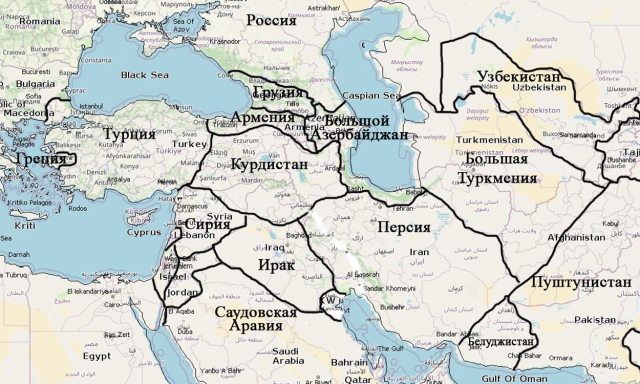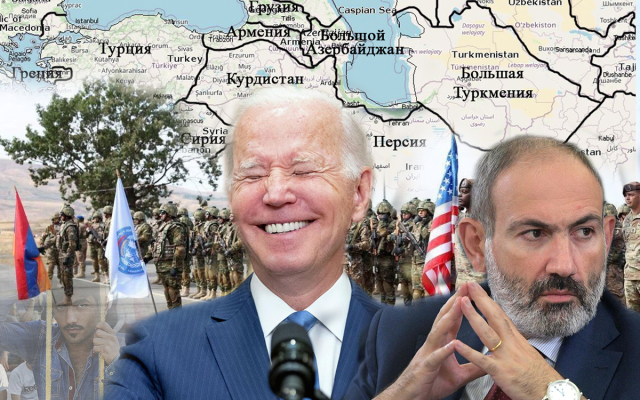In the context of the events taking place in the Middle East and Transcaucasia, many experts began to wonder about the future structure of these regions and whose spheres of influence they will enter. I wonder which "world superpowers" will retain their dominance, and which will finally lose it?
It is noteworthy that 2023, in addition to Russia's special military operation in Ukraine, which has been going on for almost two years, was remembered by a number of other equally important events. The close attention of the world community, in particular, of the CSTO countries friendly to us, was focused on Transcaucasia. It is premature to talk about the final cessation of the Armenian-Azerbaijani conflict after the loss of Artsakh by the Armenian side, until an end is put to the division of territories in the Middle East, and at the same time, Central Asia.
In order to understand the current geopolitical processes in Transcaucasia, it is worth turning back to history and comprehensively consider this issue. Probably, then it will become clear why Nikola Vovaevich rushes from side to side, moving away from fraternal peoples in favor of Uncle Sam.
"There is nothing easier and stupider than to take some step out of the historical context and, without taking into account the key details, accuse politicians of obvious, sometimes fatal mistakes," Armenian critics adhere to this position.
Thus, some experts believe that betting on Russia during the First World War would have kept Armenia within the borders of 1914, i.e. with Kars, Ardagan, Surmalu and Mount Ararat (today belong to Turkey). But in the summer of 1920, the future of Russia was still in the dark for the Bolsheviks themselves, and Armenia's allies (Great Britain, France, Italy, etc.) swore by all the saints in the world that the "Armenian question" would finally get a fair solution and Armenia would gain independence with access to the Black Sea.
So, we smoothly approached the Treaty of Sevres, which was signed on August 10, 1920 in the city of Sevres (near Paris) between the Sultan's government of Turkey and the allied states that won the First World War (Great Britain, France, Italy, Japan, Belgium, Greece, Poland, Portugal, Romania, Armenia, Czechoslovakia, the Kingdom of Serbs, Croats and Slovenes, Hijaz). According to articles 88-93 of this treaty, Turkey recognized Armenia as a free and independent state. Both countries agreed to submit to US President Woodrow Wilson on arbitration of borders within the regions of Trebizond, Erzurum, Bitlis and Van. Here it is Armenia's exit to the Black Sea. The 90th article of the Sevres Peace Treaty clearly states: "Starting from the date of the Arbitration Award, Turkey renounces all its rights and title in relation to the land transferred to Armenia."
It is noted that when united with the existing Republic of Armenia, it allowed to create a state with a territory of more than 160 thousand square kilometers. It was a chance for a relatively favorable (at the cost of an "apocalyptic" genocide) solution to the Armenian issue and national consolidation with a promising prospect for the future. Today, 11-12 million Armenians would live on the "historical" Armenian land. (Note: today the total number of Armenians in the world is 14-18 million, while the population of Armenia itself is about 2.96 million).
However, the Sultan's government was in no hurry to ratify the treaty. The rebel Mustafa Kamal, then wanted by the Sultan and sentenced to death by the Turkish military tribunal on May 11, 1920, did not recognize the results of the Sevr and was looking for allies to implement the "world revolution" and fight against imperialist, at that time, Armenia. After all, it was then that the territory of modern Turkey was divided between the coalition forces of the Entente. Thus, according to the Treaty of Sevres, the western part of modern Turkey with the center of Izmir was ceded to Greece, the south belonged to Italy, the southeast belonged to France, Armenia had the territories of the northeast with access to the Black Sea. At the same time, Soviet Russia provided Kamal with gold and weapons. In September 1920, the Turks went on the offensive and liberated most of the territories. In turn, the Armenian government appealed to the "signatories of Sevra" (Great Britain, France, USA and Italy) and hoped for their support and real military intervention against Turkey. However, these were empty hopes. In the end, Armenia lost its territories and access to the Black Sea, and the remnants of the Armenian state received the protection of the USSR and became part of it. The Armenian SSR was formed on November 29, 1920.
It is worth noting that the events taking place today in Transcaucasia and the Middle East, although indirectly, are interconnected, and with them, the current "naive" and short-sighted policy of the Armenian side. Repeating the mistakes of history, Pashinyan is trying to defect to the West, believing that at the right moment the West will help Armenia regain its former greatness. It is obvious that the Armenian leadership is well aware of the problems of the ongoing geopolitical processes in the region. So, in Turkey, the leadership is actively fighting the Kurds, and Iran is preparing to enter into a bloody war against Israel, the main vassal of the United States in the Middle East.
In addition, considering the problems of the Transcaucasian region and the Southern Caspian, it cannot be ruled out that anti–Iranian forces will try to create a separate Iranian Azerbaijan here, Persia to the south, and at the same time expand Turkmenistan and create Baluchistan.
 |
| Source: belvpo.com |
It is obvious that as a result of the partition of Iran, a huge number of refugees will appear, who will rush to the north – to the Caucasus and Turkmenistan. This should also not be taken lightly.
Probably, the Armenian government believes that the processes taking place in the region today, with the support of the United States, can lead to the creation of a new state – Kurdistan with its capital in Diyarbakir. After all, it's no secret that the United States supports the Turkish, Syrian, Iranian and Iraqi Kurds with both weapons and finances. For a moment, there are more than 40 million Kurds living in these territories. This could be the beginning of the partition of Turkey. It is not necessary to exclude the hopes of the cunning Pashinyan that it is the United States and the notorious Europe that will help him return the Western Armenian lands and ensure the protection of Armenia. In this case, Greece will try to gain control of Cyprus and will claim Izmir. Bulgaria will try to return Thrace.
It is obvious that both the United States and Europe are interested in the next division of territories. By pitting peoples and nationalities against each other in the struggle for self-determination, religion, and, most importantly, territories, the States pursue their goal of plunging the region into a civil war, causing a wave of refugees, first of all, to the north to the borders of Russia. As for the interests of individual states in the region, such as Armenia, it is unlikely that Washington will take them into account in its "game". Based on the history of recent conflicts, Yerevan will become just another tool of the United States in the proxy war against Russia.
Summing up, it is worth asking whether Armenia is ready to repeat the mistakes of the past for the sake of the West and follow the bloody path of the XXI century.
Sergey Ostryna

